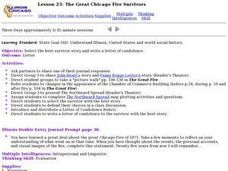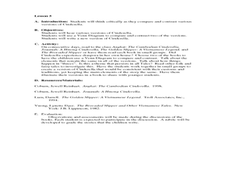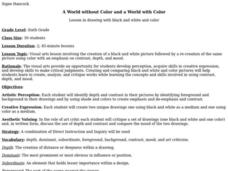Curated OER
Meet the Children of the Getty: A Set of 8 Activities
Students participate in eight activities designed to examine the many students represented in artworks at the J. Paul Getty Museum. They draw, identify shapes and patterns, analyze paintings and make personal connections with their own...
Curated OER
Historical Fiction: A Wealth of Interpretations
Students read a book from the Dear America series and contrast different points of view. They respond to the book either by participating in a literature circle or completing a journal entry. They compare and contrast two books or a...
Curated OER
Immigration Lesson Plan
Students examine immigration patterns in Canada and the United States. In this immigration lesson, students compare and contrast immigration patterns and policies in the 2 countries as they conduct research using print and Internet...
Curated OER
Pioneers Heading West
Young scholars brainstorm, analyze, compare and contrast,
and illustrate accomplishments of pioneers of the west. Students identify and interpret the Pacific Northwest pioneers. Young scholars present their final projects to the class...
Curated OER
Let's Celebrate Christmas!
Pupils compare and contrast Christmas with a variety of other holidays. They listen to the books "The Light of Christmas" and "Christmas," and generate a list about Christmas using Kidspiration computer software. Students discuss...
Curated OER
Artistic Symbols
Students compare and contrast symbols used in African and Plains Indian art. In this visual arts instructional activity, students compare symbols of 2 cultural groups found in their art. Students write a description of what items might...
Curated OER
Shadow Ball
Students examine what was occurring historically, not only in baseball, but also in the world from 1930-1940. Students discuss, compare and contrast, and graphically represent Negro Leagues and Major League baseball conditions and...
Curated OER
United States & Canada: How Are We The Same? How Are We Different?
Pupils compare and contrast similarities and differences between Canada and the US. In this geography lesson, students read various articles and identify similarities and differences in economies, cultures, geography, climate, and...
Curated OER
The Great Chicago Fire Survivors
Students compare and contrast the experiences of two survivors of the Great Fire of Chicago using a Venn Diagram.
Curated OER
Southeast Asian Folktales
Fifth graders locate and identify the countries of Southeast Asia on a map. In groups, they compare and contrast photographs and artifacts from their own lives with those living in Asia. They write their own folktales based off of...
Curated OER
Trust Circles
Students explore trustworthiness. In this character development lesson, students brainstorm synonyms for trustworthiness. Students consider two communities to which they belong, and compare and contrast these communities by completing a...
Curated OER
Show Me a Flowerpot
Students compare and contrast handmade and machine-made products in a study about the evolution of production processes in American history. In this production history instructional activity, students explore a flowerpot in depth....
Curated OER
Exploring Zoo Animals
Students research topics related to zoos and zoo animals. They compare and contrast the size of animals, make a book of facts about bears, draw snakes, and write animal stories and poetry. They complete a series of writing and creative...
Curated OER
Pearl Harbor vs September 11 Attack
Learners compare and contrast the events of the Pearl Harbor Attack and the attack on September 11, 2001 by examining the similarities and differences between these two events.
Curated OER
A World Without Color And A World With Color
Sixth graders create black and white pictures followed by a re-creation of the same picture using color with an emphasis on contrast, depth, and mood.
Curated OER
Cell Types
Fourth graders create cartoon characters which compare and contrast two types of cells: nerve and muscle. Cartoon characters show how these two cells are similar, how they are different, and the relationship between the two cell types.
Curated OER
Go For The Gold!
Third graders read fiction and nonfiction works for comprehension. Using the internet, 3rd graders participate in a WebQuest. They compare and contrast the Olympics in ancient Greece to the modern day Olympics. Afterwards, students...
Curated OER
Story Elements
Students create a "character T-shirt" that exemplifies their ability to analyze a character. The students also compare and contrast characters in a given story. Finally, the students write a presentation about the story's characters,...
Curated OER
Military Tactics and Battle Plans Oh Boy!
Eighth graders compare and contrast a Loyalist and a Patriot. After reading selected pages in the book, 8th graders use a graphic organizer to examine the battle plans of the colonists and the British during the Revolutionary War. They...
Curated OER
Let's Celebrate Diwali!
Learners list prior knowledge of Diwali. They listen to books. Students compare and contrast Diwali to other celebrations. They create a project. Learners create a letter to parents explaining about Diwali and the Diya. They ask an...
Curated OER
Exploring Technology in Careers
Students discover how technology is used in the workplace. In this careers lesson, students compare and contrast careers and how technology is incorporated into each of them. Students set goals to achieve their ideal career.
Curated OER
Central Tendency
Fifth graders compare and contrast different sets of data on the basis of measures of central tendency.
Curated OER
Life of a Logger
Students are introduced to the work and lives of 19th century lumberjacks through a living history slide show presentation. They compare and contrast life 150 years ago with the present. Students describe the history of logging in...
Curated OER
Animals
Second graders define and describe the characteristics of a mammal and a mammal's importance to man. They also describe the life cycle of a frog and compare and contrast a larva and an adult frog. Finally, 2nd graders study and explain...

























